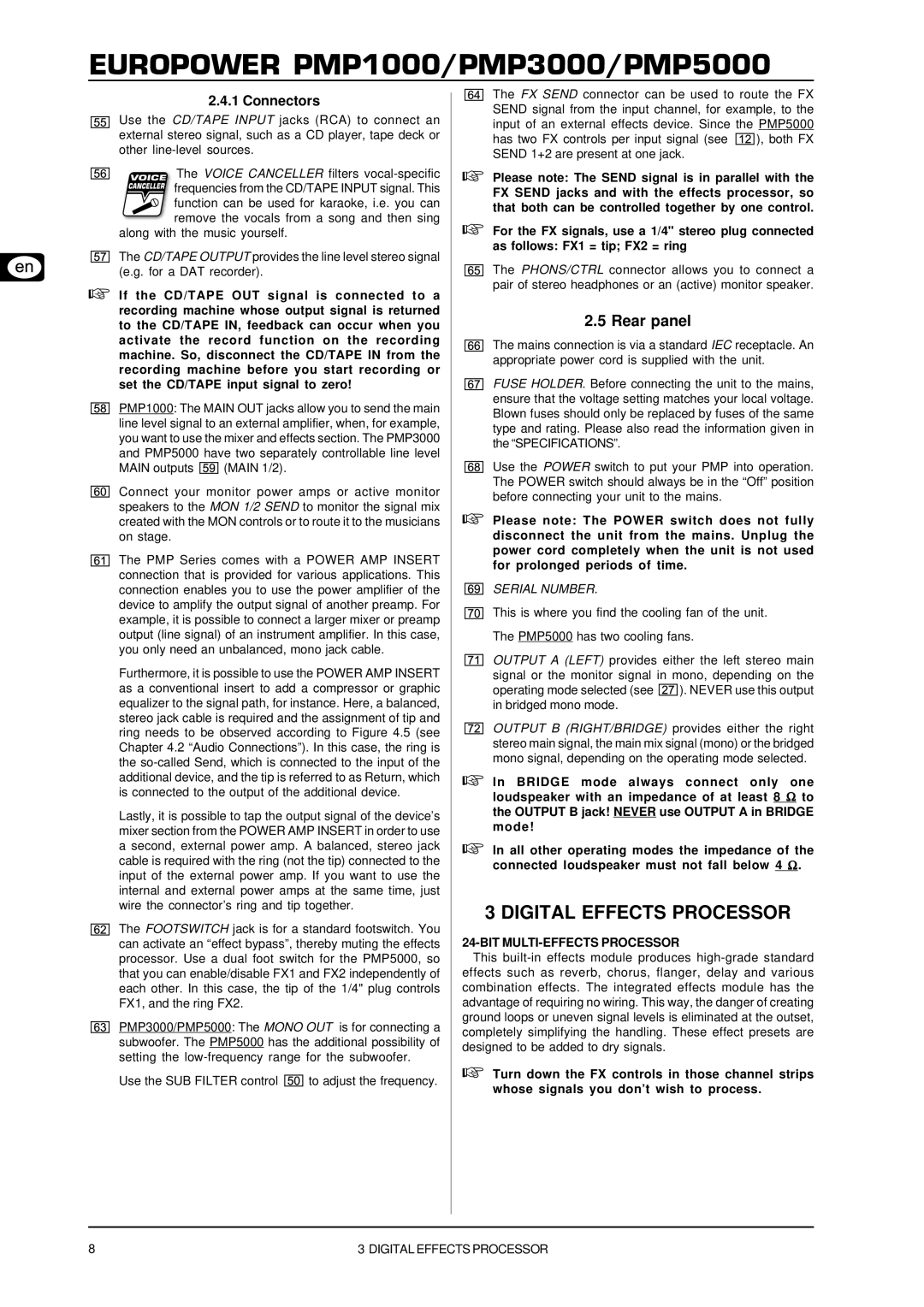2.4.1 Connectors
Use the CD/TAPE INPUT jacks (RCA) to connect an external stereo signal, such as a CD player, tape deck or other line-level sources.
The VOICE CANCELLER filters vocal-specific
frequencies from the CD/TAPE INPUT signal. This
function can be used for karaoke, i.e. you can remove the vocals from a song and then sing
along with the music yourself.
The CD/TAPE OUTPUT provides the line level stereo signal (e.g. for a DAT recorder).
If the CD/TAPE OUT signal is connected to a recording machine whose output signal is returned to the CD/TAPE IN, feedback can occur when you activate the record function on the recording machine. So, disconnect the CD/TAPE IN from the recording machine before you start recording or set the CD/TAPE input signal to zero!
PMP1000: The MAIN OUT jacks allow you to send the main line level signal to an external amplifier, when, for example, you want to use the mixer and effects section. The PMP3000 and PMP5000 have two separately controllable line level
MAIN outputs 

 (MAIN 1/2).
(MAIN 1/2).
Connect your monitor power amps or active monitor speakers to the MON 1/2 SEND to monitor the signal mix created with the MON controls or to route it to the musicians on stage.
The PMP Series comes with a POWER AMP INSERT connection that is provided for various applications. This connection enables you to use the power amplifier of the device to amplify the output signal of another preamp. For example, it is possible to connect a larger mixer or preamp output (line signal) of an instrument amplifier. In this case, you only need an unbalanced, mono jack cable.
Furthermore, it is possible to use the POWER AMP INSERT as a conventional insert to add a compressor or graphic equalizer to the signal path, for instance. Here, a balanced, stereo jack cable is required and the assignment of tip and ring needs to be observed according to Figure 4.5 (see Chapter 4.2 “Audio Connections”). In this case, the ring is the so-called Send, which is connected to the input of the additional device, and the tip is referred to as Return, which is connected to the output of the additional device.
Lastly, it is possible to tap the output signal of the device’s mixer section from the POWER AMP INSERT in order to use a second, external power amp. A balanced, stereo jack cable is required with the ring (not the tip) connected to the input of the external power amp. If you want to use the internal and external power amps at the same time, just wire the connector’s ring and tip together.
The FOOTSWITCH jack is for a standard footswitch. You can activate an “effect bypass”, thereby muting the effects processor. Use a dual foot switch for the PMP5000, so that you can enable/disable FX1 and FX2 independently of each other. In this case, the tip of the 1/4" plug controls FX1, and the ring FX2.
PMP3000/PMP5000: The MONO OUT is for connecting a subwoofer. The PMP5000 has the additional possibility of setting the low-frequency range for the subwoofer.
Use the SUB FILTER control 

 to adjust the frequency.
to adjust the frequency.
The FX SEND connector can be used to route the FX SEND signal from the input channel, for example, to the input of an external effects device. Since the PMP5000
has two FX controls per input signal (see 


 ), both FX SEND 1+2 are present at one jack.
), both FX SEND 1+2 are present at one jack.
Please note: The SEND signal is in parallel with the FX SEND jacks and with the effects processor, so that both can be controlled together by one control.
For the FX signals, use a 1/4" stereo plug connected as follows: FX1 = tip; FX2 = ring
The PHONS/CTRL connector allows you to connect a pair of stereo headphones or an (active) monitor speaker.
2.5 Rear panel
The mains connection is via a standard IEC receptacle. An appropriate power cord is supplied with the unit.
FUSE HOLDER. Before connecting the unit to the mains, ensure that the voltage setting matches your local voltage. Blown fuses should only be replaced by fuses of the same type and rating. Please also read the information given in the “SPECIFICATIONS”.
Use the POWER switch to put your PMP into operation. The POWER switch should always be in the “Off” position before connecting your unit to the mains.
Please note: The POWER switch does not fully disconnect the unit from the mains. Unplug the power cord completely when the unit is not used for prolonged periods of time.
SERIAL NUMBER.
This is where you find the cooling fan of the unit.
The PMP5000 has two cooling fans.
OUTPUT A (LEFT) provides either the left stereo main signal or the monitor signal in mono, depending on the operating mode selected (see 

 ). NEVER use this output in bridged mono mode.
). NEVER use this output in bridged mono mode.
OUTPUT B (RIGHT/BRIDGE) provides either the right stereo main signal, the main mix signal (mono) or the bridged mono signal, depending on the operating mode selected.
In BRIDGE mode always connect only one loudspeaker with an impedance of at least 8 Ω to the OUTPUT B jack! NEVER use OUTPUT A in BRIDGE mode!
In all other operating modes the impedance of the connected loudspeaker must not fall below 4 Ω.
3 DIGITAL EFFECTS PROCESSOR
24-BIT MULTI-EFFECTS PROCESSOR
This built-in effects module produces high-grade standard effects such as reverb, chorus, flanger, delay and various combination effects. The integrated effects module has the advantage of requiring no wiring. This way, the danger of creating ground loops or uneven signal levels is eliminated at the outset, completely simplifying the handling. These effect presets are designed to be added to dry signals.
Turn down the FX controls in those channel strips whose signals you don’t wish to process.

